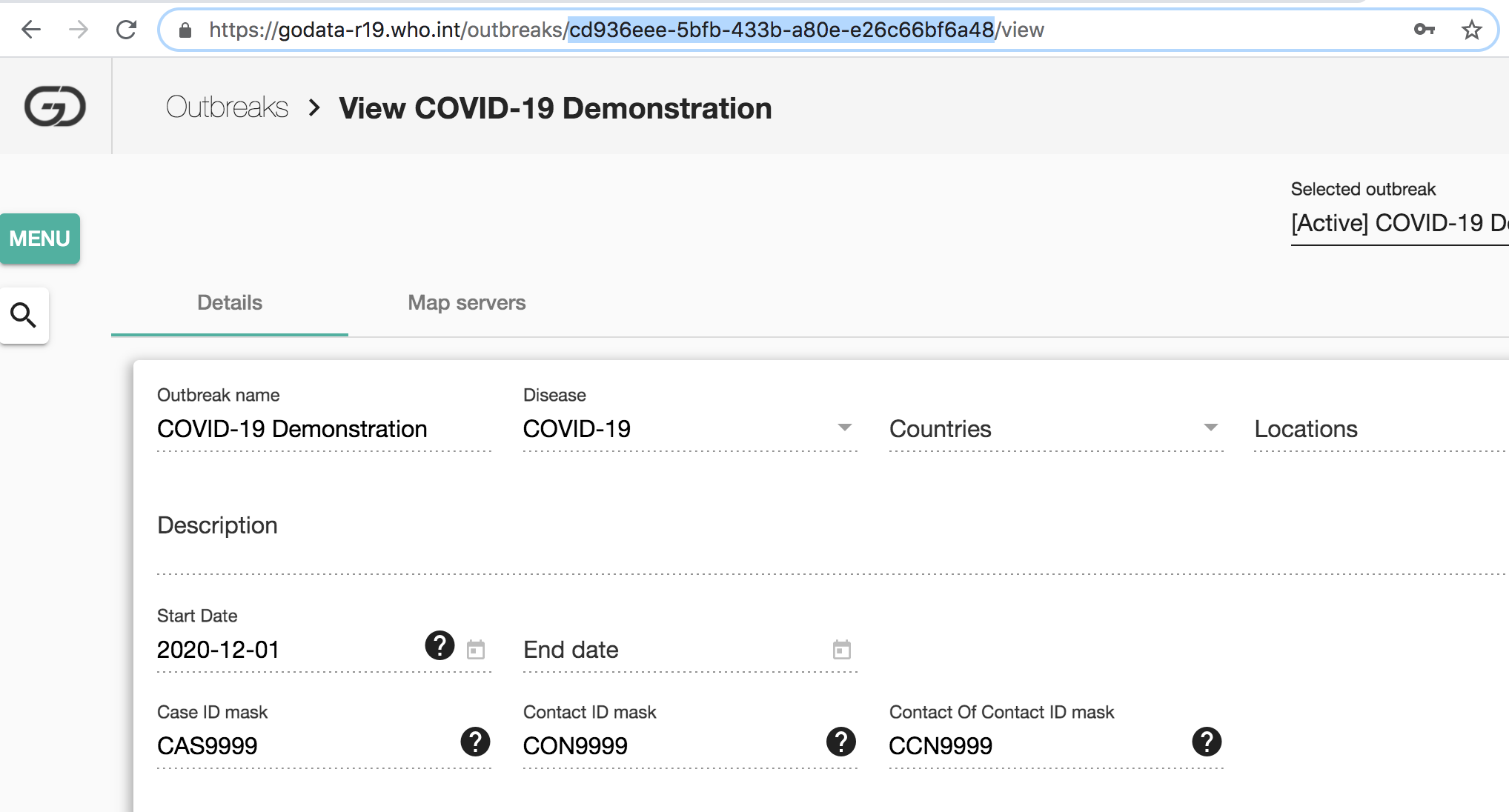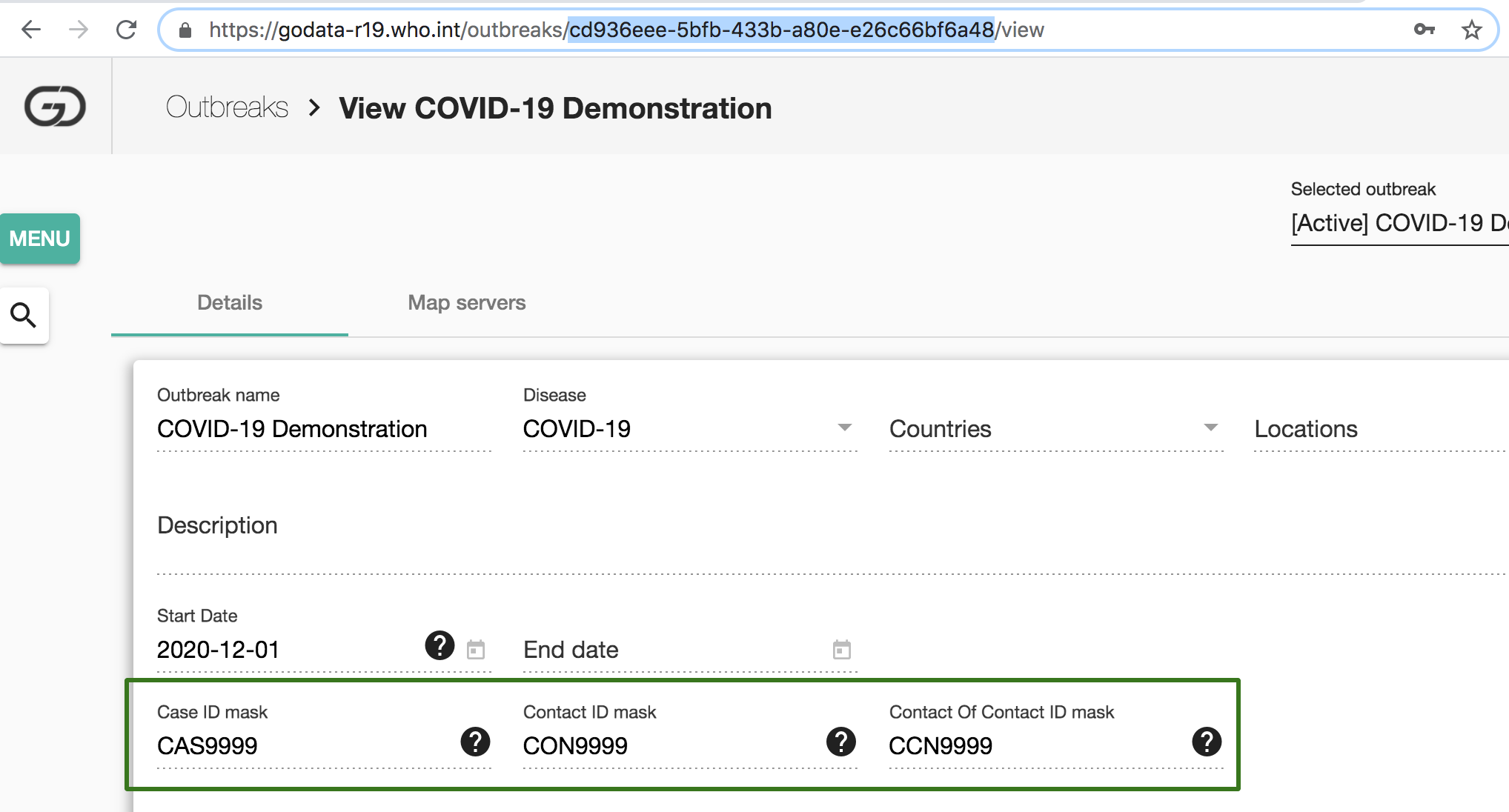Go.Data Unique Identifiers & Integration Considerations
1. Unique identifier schemes
When interoperating with other systems, determining unique identifiers for every shared resource is critical to developing shared records, preventing duplicates, and preserving data integrity.
Go.Data Global Record Ids (GUIDs)
All records created in Go.Data are assigned a system-generated internal Globally Unique Identifier (id). GUIDs (e.g., 8c71e61f-fb11-4d4f-9130-b69384b6e4e4) are used as primary keys for records in the MongoDB, and are required to request and update Go.Data records via the API.
GET /api/outbreaks/8c71e61f-fb11-4d4f-9130-b69384b6e4e4 POST /api/outbreaks/8c71e61f-fb11-4d4f-9130-b69384b6e4e4/cases/3b5554d7-2c19-41d0-b9af-475ad25a382b
On the front end, you can find this id in the URL of a record you are viewing… 
Case & Contact IDs
Users can also choose to define ID mask for Cases and Contacts to assign a human-readable identification pattern that Go.Data will use to create a globally unique identifier to track each case. These IDs can be configured when first setting up an Outbreak.

Mask IDs
Note the following Mask ID* naming conventions when constructing your identifier.
0: Digit (0 through 9)9: Digit (auto-generated sequence number)Y: Year (Using year from the dateOfReporting)@: Letter (A through Z)&: Any character including spaces*: For any character with no limitations in ID length
Examples
Case Mask ID: *might be used if we wanted to import an external identifier forcase_idwith no limits on characters (e.g.,028391BX01,827JN09K11)Case Mask ID: CASE-99999might be used if we wanted to auto-assign an autonumbercase_idwith a standard prefix (e.g.,CASE-00001,CASE-00002)Case Mask ID: @@@-999999999might be used if we wanted to importcase_idthat included country code and national Id number (e.g.,SEN-021929192)
Notes for Mask ID Creation
- If interacting with this
Mask IDvia the API, this is variable is labeled asvisualIdin all the body of API responses. - If a
CaseorContactrecord is converted, its Mask ID (andvisualId) does not change. Consider this when determining your Mask ID naming convention because if you include string values likeCASEin the identifier, then this might confuse users if acaserecord is converted to acontact.
Determining your own custom unique identifier scheme
If a unique identifier scheme is not already available, consider the following approaches to developing your own custom identifier scheme…
- autonumbers (e.g.,
CASE-000001) - national Ids or other available document-based Ids (see below)
- concatenating attributes available in your dataset (e.g.,
surname-dateOfBirth,location-surname-birthYear) ___________
National IDs and Importing Other Existing Identifiers
If you have an existing unique identifier used in external systems, such as a National ID, you may choose to implement this as the unique identifier scheme in the Go.Data system so that all Go.Data Contact or Case records will also be tagged with this Id.
To import this external identifier to Go.Data…
- Consider setting the
Case Mask ID: *so that you can freely import this external identifier with no constraints (or use aMask IDlike99999999if you know that the Id has a standard format of 8 digits. - If you prefer that all
ContactsorCasesalso be assigned a Go.Data-generated identifier, then you may instead choose to set theCase Mask IDto a custom identifier scheme, and rather use theDocumentvariable (see below) to also capture theNational IDor other external identifier.
‘Document’ variable
On Case and Contact there is a standard Document variable available for users to specify other Document identification (e.g., national ID, passport).

Questionnaire custom variables
Questionnaires are essential for collecting and recording data for cases, contacts, and lab results during an outbreak. A pre-established questionnaire format for an outbreak ensures that data collected is consistent across the outbreak, so you can more easily perform analysis on the information.
You can choose to add custom variables to also capture custom metadata like an external identifier.

‘Upsert’ Operations
“Upsert” operations are a data import pattern where you first check if a record exists using an external identifier, and then either update or insert a new record dependng on whether an existing record is found. If exchanging data with an external system, in every data import it is best practice to replicate this pattern of…
- search by unique
identifier, and then - update existing OR insert a new record depending on the search results in
1
Therefore if importing data via the API, consider implementing a HTTP request pattern where you…
GETexisting records and filter the results by the available uniqueidentifier, and thenPUTto update existing, orPOSTto create a new record
Go.Data Duplicate Management Features
For scenarios where your unique identfier scheme fails, Go.Data offers some out-of-box feature for duplicate-checking across different record attributes (e.g., name, dateOfBirth). See the User Guide to learn more.